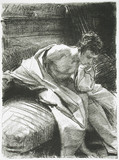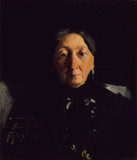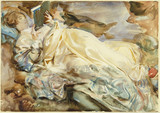The foremost Anglo-American portrait painter of his time, John Singer Sargent based his career in Paris and London, although he made several extended trips to the United States. In 1874 he entered the atelier of Carolus-Duran (1837-1917) and was admitted to the Ecole des Beaux-Arts. Three years later he began exhibiting at the Paris Salon; in 1878 he received much praise for his The Oyster Gatherers of Cancale, 1878 (Corcoran Gallery of Art, Washington, D.C.), and the next year won honorable mention for his portrait of his teacher, Carolus-Duran (Sterling and Francine Clark Art Institute, Williamstown, Mass.). That year he traveled to Holland and Spain to study the portraits of Frans Hals (1580-1666) and Diego Velázquez (1599-1660) and visited North Africa and Venice. Because of the public scandal when his portrait Madame X, 1884 (Metropolitan Museum of Art, New York), was shown at the Paris Salon of 1884, he moved to England and began exhibiting with the progressive New English Art Club. He spent several summers during the 1880s at the Anglo-American colony of artists and writers in Broadway in the Cotswolds and at Giverny, France, with Claude Monet (1840-1926). The colorful, light filled landscapes he painted at both locales reflect the growing influence of impressionism on his art.
Sargent developed a cosmopolitan style of portraiture, depicting his sophisticated, wealthy sitters in harmony with their sumptuous surroundings. In late 1889 he visited New England and New York to fulfill several portrait commissions and while there was selected to paint murals for the Boston Public Library. He then traveled to Egypt to gather material for the murals, to be about the history of Judaism and Christianity. In 1897 he was elected to the Royal Academy. By the early 1900s he had become increasingly bored with portraiture, which in 1907 he all but abandoned, making more modest portrait drawings for his clients while devoting himself increasingly to landscape painting. Watercolor had now become his favorite medium. In London in 1904 he exhibited at the Royal Society of Painters in Water-Colours and in 1907 at the Pastel Society. In 1916, the year he completed the Boston Public Library decorations, he was commissioned to design murals for the Museum of Fine Arts, Boston. The only significant work from his last years was Gassed, 1918-19 (Imperial War Museum, London), painted for the British Ministry of Information.
BIBLIOGRAPHY
William Howe Downes, John S. Sargent: His Life and Work (Boston: Little, Brown, 1925), with catalogue of oil paintings, watercolors, and drawings, bibliography § Evan Charteris, John Sargent (1927; reprint, New York: Benjamin Blom, 1972), with Vernon Lee’s "J.S.S.: In Memoriam," catalogue of oil paintings § Stanley Olson, John Singer Sargent: His Portrait (New York: St. Martin’s, 1986), with genealogies of Sargent family, reprint of Sargent’s description of Boston Public Library decorations, bibliography § Robert H. Getscher and Paul G. Marks, James McNeill Whistler and John Singer Sargent: Two Annotated Bibliographies (New York: Garland, 1986), the most extensive bibliography on the artist § New York, Whitney Museum of American Art, and Art Institute of Chicago, John Singer Sargent, exh. cat., 1986 (copublished with Harry N. Abrams, New York), with text by Patricia Hills and others, chronology, bibliography.




